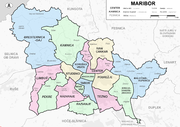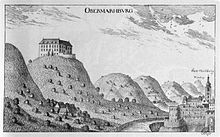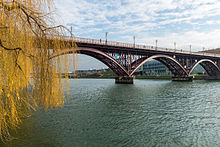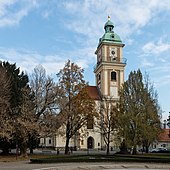Maribor
|
Maribor Marburg on the Drau |
||||
|
||||
| Basic data | ||||
|---|---|---|---|---|
| Country |
|
|||
| Historic region | Lower Styria / Štajerska | |||
| Statistical region | Podravska (Drau region) | |||
| Coordinates | 46 ° 33 ' N , 15 ° 39' E | |||
| height | 275 m. i. J. | |||
| surface | 147.5 km² | |||
| Residents | 112,065 (January 1, 2019) | |||
| Population density | 760 inhabitants per km² | |||
| Telephone code | (+386) 02 | |||
| Post Code | 2000 | |||
| License Plate | MB | |||
| Structure and administration | ||||
| Mayor : | Aleksander Arsenovič | |||
| Mailing address | Ulica heroja Staneta 1 2000 Maribor |
|||
| Website | ||||

Maribor ( German , mainly used in Austria : Marburg an der Drau ) is a city and municipality in northeastern Slovenia and with 112,065 inhabitants (2019) (agglomeration: 168,000) its second largest city. It is a Roman Catholic archbishopric and has been home to the University of Maribor since 1975 .
Maribor was named Alpine City of the Year 2000 and was European Capital of Culture in 2012 .
geography
location
Maribor is located at the foot of Pohorje ( Pohorje ) south and Windisch Bühel ( Slovenske Gorice ) north of the city, on the banks of the Drava River ( Drava ).
The city is the largest in the Slovenian region of Lower Styria ( Štajerska ). The nearest major city, Graz in Austrian Styria , is 60 km north. With Graz ( Slov .: Gradec ), Maribor now has closer cultural and economic ties again. One example of this is the Graz-Maribor European region .
City structure
The municipality of Maribor is divided into 11 districts ( Slov .: Mestne četrti , abbreviation: MČ ) and six local communities ( Slov .: Krajevne skupnosti , abbreviation: KS ). Both variants essentially fulfill the same tasks, the only difference is that the city districts comprise at least part of the core city, while a local community is an amalgamation exclusively of villages in the surrounding area that belong to the city municipality.
The municipality is also divided into 34 localities. However, this division has no administrative consequences.
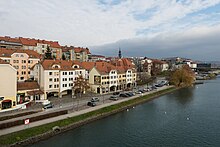
|
City district ( Mestne četrti ):
|
Local communities ( Krajevne skupnosti ):
|
history
| Country | Belonging to the administrative unit |
from ... to |
|---|---|---|
|
|
||
| Margraviate of Styria | 1164-1180 | |
| Duchy of Styria (from 1282 Habsburg , 1379 / 1411–1457 and 1564–1619 Inner Austria ) |
1180-1804 | |
|
|
Duchy of Styria | 1804-1867 |
|
|
Duchy of Styria ( Cisleithanien ) |
1867-1918 |
|
|
||
| Slovenia Province | 1918-1922 | |
| Maribor Oblast | 1922-1929 | |
| Drava Banschaft | 1929-1941 | |
|
|
CdZ area Lower Styria | 1941-1945 |
|
|
||
| People's Republic of Slovenia | 1945–1963 | |
| Socialist. Rep. Slovenia | 1963-1990 | |
| Republic of Slovenia | 1990-1991 | |
|
|
Municipality of Maribor | since 1991 |
At Habsburg
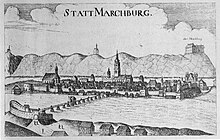
Marburg goes back to a Markburg or Marchburg mentioned in 1164 , which gave the settlement its name. Mark and March are old German names for " Grenz ". In 1204 the place was first mentioned as a market and in 1254 as a city. The first mention of Jews comes from the year 1270, it is a document that confirms the purchase of vineyards by Jews; in addition, a cemetery is mentioned in 1367 and a synagogue is mentioned for the first time in 1429 . In 1497, on the orders of Maximilian I, the Jewish families from Styria had to leave their residential areas, including the Jews of Marburg, which was a severe blow to the Marburg economy.
→ History of the Jews in Styria
In 1480 and 1481 the city was besieged by Matthias Corvinus in vain. The rule of Marburg , Obermarburg and the town castle belonged to the Lords of Walsee , from 1456 to the Lords of Graben and from 1564 to their heirs, the Lords of Stadl . In 1620 the Counts Zwickl called Khiesl acquired the rule, from 1727 it belonged to Count Brandis .
The name Maribor was only created by the poet Stanko Vraz in the 19th century with the rise of the Slovene national consciousness .
A lexicon from 1896 summarized: Marburg had three bridges, a cathedral, a parish tower, a count's castle, a casino with a theater, a city park and around 20,000 mostly German-speaking residents . Factories, wine and timber trade, credit institutions completed the picture, as well as two district courts, the seat of the Prince-Bishop of Lavant as well as high schools and a teacher training institute. Marburg was a city with its own statute (so it was not subject to any district of the state of Styria), and there was a separate district administration for the area around the city .
In 1882 Hermann Goethe (1837–1911) founded the Marburg wine and fruit growing school. Among other things, she published specialist literature on grape variety, so-called ampelographic reports , which reached significance beyond the borders of the monarchy.
Marburg remained until the end of the First World War in 1918 as part of the Duchy of Styria and thus Austria-Hungary under the rule of the Habsburgs . During this war, suspected public hostility led to the forced internment of many Slovenes in Carinthia and Styria, which led to violent clashes between the German-speaking and Slovenian ethnic groups.
Decision 1918/19
When Austria-Hungary dissolved in autumn 1918, the predominantly German-Austrian city was claimed by the newly founded Republic of German Austria , but also by the newly founded state of Slovenes, Croats and Serbs . The Slovenes who settled in the surrounding area had a strategic advantage: The closed German-speaking settlement area of Styria in the north was about fifteen kilometers away. The Imperial and Royal Landsturm Commandant Rudolf Maister , who was in office in Marburg, declared himself city commander in early November 1918, supported by Slovenian troops, and was promoted to general by the new Ljubljana government. The German-Austrian city politicians were deposed. The remaining German-Austrian garrison and the vigilantes formed by German-Austrians had to give up after a few weeks. This anticipated the later regulation in the Treaty of Saint-Germain (September 1919).
On January 27, 1919, 13 German Marburgers who were waiting on the main square for the US peace delegation were shot by Maister's soldiers and more than 60 injured ( Marburg Bloody Sunday ). What triggered the shooting at the unarmed remained unclear. There were widely divergent statements about this; in any case, there was no central order. Marburg was assigned to the Kingdom of Serbs, Croats and Slovenes ( SHS State , later Kingdom of Yugoslavia ) as part of the largely Slovenian Lower Styria without a referendum and against the will of the freely elected municipal councils, state parliament and Reichsrat members .
Slovenes and German Austrians
The German-Austrian population group made up the vast majority until the end of the First World War and dominated public life (the 1890 census showed 19,898 inhabitants, 2,653 of whom were Slovene-speaking). This also applied to the neighboring villages Brunn village (Studenci) , Pobersch (Pobrežje) , theses (Tezno) , red wine (Radvanje) , Roßwein (Razvanje) , Kartschowin (Krčevina) and Head Mountain (Kosaki) , with the city of Marburg, a German linguistic island formed . In the 1910 census, 81% German and 14% Slovene-speaking residents lived here.
The rest of the surrounding area was - with the exception of other smaller towns such as Pettau ( Ptuj ) , St. Leonhard in Windischbüheln ( Lenart v Slovenskih Goricah ) , Luttenberg ( Ljutomer ) , Friedau ( Ormož ) , Windisch-Feistritz (Slovenska Bistrica) and Pragerhof ( Pragersko) - almost entirely populated by Slovenes . Although after the First World War part of the German-Austrian population (above all the civil servants, partly already under General Maister's military rule) was expelled to Austria and all German schools and clubs were forcibly dissolved or confiscated, the German proportion in the 1930s was according to information from Minority still around 25%. However, the censuses in 1921 only showed 21% and in 1931 only 7% German speakers.
Lower Styria and National Socialism
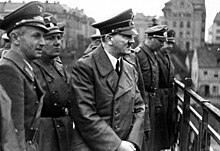
After the attack of the German Reich on the Kingdom of Yugoslavia on April 6, 1941, the Yugoslav part of Styria was annexed to the Greater German Reich as the Lower Styria CdZ area . Hitler visited the city on April 26, 1941 and, in a speech at a large rally, urged his supporters to “make this country German again”. As from the surrounding area, Slovenes were also deported from the city to Serbia and to the German Reich for forced labor . Those who were suspected of promoting the Yugoslav partisans were executed; the death sentences were posted in the city as a deterrent. (A related memorial is in the old town.) During the Second World War , the city was bombed several times by Allied planes.
1945 to 1990
The largest mass grave of the Bleiburg massacre is located in Maribor-Tezno . During the construction of the motorway in 1999, skeletons or bones of 1179 people were found over a length of around 70 meters. Further explorations from 2007 under the direction of Mitja Ferenc showed that an anti-tank trench was evenly filled over a length of 940 meters and thus suggests a number of victims of around 15,000. The mass executions in Tezno took place from May 20 to 26, 1945. The mass grave has not yet been completely excavated, nor has it been identified at all. (Stand 2013)
From the summer of 1945, German-speaking Marburgers who had not previously fled were expelled to Austria and their property was confiscated. An individual determination of their guilt or innocence did not take place.
After 1945 the city developed into a flourishing industrial and cultural center for the entire north of Slovenia and Yugoslavia.
Since 1969 there has been a town partnership with the Hessian city of Marburg an der Lahn, since 1987 with the Styrian capital Graz .
In 1975 the University of Maribor was founded.
Since 1991
Since Slovenia's declaration of independence from Yugoslavia in 1991, the entire newly established republic has lost the internal Yugoslavian market. The impact of this loss on the city's economy was significant, resulting in high unemployment . Between 1996 and 2001 the city lost an average of 3.1% of its inhabitants every year. The accession of Slovenia to the European Union in 2004, the introduction of the euro in 2007 and the accession of Slovenia to the Schengen area , which at the end of 2007 led to the abandonment of all border controls towards Austria, Hungary and Italy, should allow new optimism.
Maribor was the Council of the European Union for the Capital of Culture proclaimed in 2012, as well as Guimarães in Portugal .
General
Larger city fires are recorded in 1513, 1601, 1648, 1650, 1700 and 1797. But the fires did not cause any significant damage. The city administration therefore had a statue for St. Florian , which was set up on the square in front of the town hall. St. Florian is recognized worldwide as a protector against fires, floods and other natural disasters. Around 1860 the monument was dismantled and put into storage due to the increasing traffic. It was not until 1970 that the statue was moved to a new location on Burgplatz.
population
The 2002 census showed: 89.2% of the residents of Maribor were Slovene citizens, 4.1% Croats , 2.6% Bosnians , 2.3% Yugoslavs (today: Serbs and Montenegrins ), 1.0% EU citizens (then EU-15), 0.5% Macedonians and 0.3% others.
Slovenian is the only official language of the municipality of Maribor and was given as the mother tongue of 86.1% of the population in this census . Furthermore, according to their own information, 3.7% spoke Croatian , 1.8% Serbian , 1.3% Serbo-Croatian and 3.2% other languages.
Members of the small German-speaking group founded a “cultural association of German-speaking women, bridges” in Maribor in 2000, which, according to their own statements, wants to “preserve the linguistic, ethnic and cultural characteristics of the German-speaking population in Slovenia [...]”.
| year | number | Remarks |
|---|---|---|
| 1880 | 17,628 | 13,517 German speakers (76.7%), 2,431 Slovenes (13.8%) |
| 1890 | 19,898 | 15,590 German speakers (78.3%) 2,653 Slovenes (13.3%) |
| 1900 | 24,601 | 19,298 German speakers (78.4%) 4,062 Slovenes (16.5%) |
| 1910 | 27,994 | 22,653 German speakers (80.9%), 3,828 Slovenes (13.7%) |
| 1921 | 30,662 | 6,595 German speakers (21.5%), 20,759 Slovenes (67.7%) |
| 1931 | 33.131 | 2,741 German speakers (8.3%) |
| 1941 | 57,410 | |
| 1948 | 65.009 | 268 German speakers (0.4%), 60,940 Slovenes (93.7%) |
| 2002 | 94,828 | |
| 2011 | 95.171 | |
| 2019 | 112.065 | Around 2015 the population of 100,000 was exceeded for the first time. |
| year | Population of the Maribor municipality |
|---|---|
| 1961 | 152.939 |
| 1971 | 171,745 |
| 1981 | 185,699 |
Regular events (selection)
Every January, bears the located on the outskirts ski resort Maribor Pohorje , in which, after a four-year break since 2007, the downhill - and four-cross - Mountain Bike World Cup guest appearance, the race for the Golden Fox as part of the Alpine World Cup of.
In February Maribor since 1992 is annually the scene of FinsSwimWorldCup ( German: fin swimming -Weltcup).
The two-week Lent Festival , named after the Lent district on the banks of the river Drau , takes place every June with hundreds of music, theater and cabaret events.
In September, the two-week Music September (glasbeni september) expects visitors from all over the world.
In the old army bakery ( Pekarna , "bakery") the punk festival No Border Jam takes place every August .
Attractions
- Old grapevine on the Lent ( Stara Trta ) - the oldest grapevine in the world grows on the banks of the Drava (its age is estimated to be over 400 years).
- Basilica of the Mother of Mercy on Partizanska cesta , built 1892–1900 according to plans by the Viennese architect Richard Jordan
- Liberation Monument on Liberation Square ( Trg Svobode ), inaugurated in 1975; Its design is reminiscent of a historical helmet or a prison gate. It was built in memory of around 700 people who died from 1941 to 1945 in the fight against the German occupation of the city.
- Maribor Cathedral: Cathedral Church of St. John the Baptist (sv. Janeza Krstnika) or Cathedral on Slomškov Square - built in the 12th century
- Cultural events center (narodni dom) with a monument to Prince Kocelj - built in 1897–1898 based on designs by the Bohemian architect Jan Veyrich
- Town hall on the main square (Glavni trg)
- City castle (Mariborski grad) - built 1478–1483 under Emperor Friedrich III.
- Water tower (vodni stolp) - built in the 16th century and part of the Renaissance city fortress.
traffic
railroad
Maribor is located at 1838 furnished old Austrian Southern Railway Vienna - Graz -Maribor- Zidani Most - Ljubljana - Postojna - Trieste and once also from the private Southern Railway Company operated west-east axis Fortezza (Brennerbahn) - Lienz - Villach ( Tauern train ) - Klagenfurt - Dravograd –Maribor. For this purpose, a railway bridge was built over the Drau in 1844, which was 209 m long, had two tracks and was made of wood. In 1866, today's three-track, three-arched steel bridge was completed in place of the first wooden structure. On June 2, 1846, the first train set with the steam locomotive Ocean arrived in the city . Die Bahn operated large workshops in Marburg. In the 21st century, both routes are operated by the state railway companies of Slovenia , Austria and Italy .
Public transport
Several bus lines handle the volume of traffic directly in the city.
In addition, there are a total of 11 long-distance bus routes in the 21st century, including to Berlin, Munich, Freiburg, Stuttgart, Vienna, Graz and Zurich.
Private motor transport
Maribor is connected to the city of Celje and the capital Ljubljana by the A1 motorway . To the north, there is a connection to the Austrian motorway A9 Spielfeld / State Border - Graz, via which you can get to the Vienna and Bratislava area as well as Upper Styria , Salzburg and Germany . The A5 motorway to the east, completed in 2008, connects Maribor with Murska Sobota and the city of Nagykanizsa in Hungary.
The traffic between the Czech Republic and Eastern Austria and the Adriatic ports of Trieste and Rijeka ran (and continues) by rail and road largely via Maribor.
flight
Maribor Airport is located ten kilometers south of the city center, near Slivnica .
Twin cities
-
 Graz ( Austria ), since 1987
Graz ( Austria ), since 1987 -
 Greenwich ( United Kingdom )
Greenwich ( United Kingdom ) -
 Kraljevo ( Serbia )
Kraljevo ( Serbia ) -
 Marburg ( Germany ), since 1969
Marburg ( Germany ), since 1969 -
 Osijek ( Croatia )
Osijek ( Croatia ) -
 Pétange ( Luxembourg ), since 1992
Pétange ( Luxembourg ), since 1992 -
 Pueblo ( United States )
Pueblo ( United States ) -
 Saint Petersburg ( Russia )
Saint Petersburg ( Russia ) -
 Szombathely ( Hungary )
Szombathely ( Hungary ) -
 Tours ( France )
Tours ( France ) -
 Udine ( Italy )
Udine ( Italy )
Personalities
In the media
In the work of Johann Gottfried Seume : Walk to Syracuse , the place is one of the stops on his journey.
The Marburger Zeitung appeared in Marburg from 1862 to 1945 . The paper, which appears three times a week, saw itself as a representative of Germanness in the predominantly Slovenian Lower Styria .
literature
- Marjeta Ciglenečki: Maribor / Marburg on the Drau. An art history tour . Schnell & Steiner, Regensburg / German Cultural Forum for Eastern Europe, Potsdam 2012, ISBN 978-3-7954-2504-3 .
- Tamara Griesser-Pecar: Maribor / Marburg an der Drau. A little city history . Böhlau Verlag, Vienna 2011, ISBN 978-3-205-78720-4 .
- Rudolf Pertassek : Marburg on the Drau. From the “Marchburch” to the university town . Edition Strahalm, Graz 2000, ISBN 3-900526-61-3 .
- Sergej Vrišer: Maribor . Illustrated book, Motovun, Ljubljana 1984.
- Franc Vogelnik, Bogo Čerin: Maribor . Ljubljana 1988, ISBN 86-361-0513-7 .
- Margarete Weinhandl : Youth in the wine country . Munich 1962.
- Adolph Stiller (Ed.): Marburg - Maribor. A city panorama for the European Capital of Culture 2012 . Architecture in the Ringturm XXIX. Müry Salzmann Verlag, Salzburg 2012, ISBN 978-3-99014-067-3 .
- Manica Špendal: Marburg an der Drau (Maribor). In: Oesterreichisches Musiklexikon . Online edition, Vienna 2002 ff., ISBN 3-7001-3077-5 ; Print edition: Volume 3, Verlag der Österreichischen Akademie der Wissenschaften, Vienna 2004, ISBN 3-7001-3045-7 .
Web links
Individual evidence
- ↑ German name according to the Federal Institute for Culture and History of Germans in Eastern Europe (BKGE)
- ↑ Population tables of the Statistical Office of the Republic of Slovenia ( Slovene )
- ↑ Karl Wilhelm Mayer: Karl Mayer's attempt on Steyermark antiquities, and some strange objects. with von Widmannstättenschen Schriften, Graz, 1782, p. 164 ( limited preview in the Google book search).
- ↑ Meyer's large pocket dictionary . 7th edition. Mannheim 1999, ISBN 3-411-11007-4 , Volume 14, p. 125.
- ↑ maribor.uni-mb.si ( Memento of the original from September 30, 2006 in the web archive archive.today ) Info: The archive link was automatically inserted and not yet checked. Please check the original and archive link according to the instructions and then remove this notice.
- ↑ Maribor introduces itself. ( Memento of the original from September 30, 2006 in the Internet Archive ) Info: The archive link was automatically inserted and not yet checked. Please check the original and archive link according to the instructions and then remove this notice. University of Maribor
- ^ Meyers Konversations-Lexikon, 5th edition, Bibliographisches Institut, Leipzig and Vienna 1896, 11th volume, p. 901.
- ^ Yearbook of the Federal Institute for Culture and History of Germans in Eastern Europe, Volume 13, 2005, p. 175.
- ↑ Past and present. Quarterly issues for contemporary history, social analysis and political education. 4, Styria, p. 141 (1985).
- ↑ Mitja Ferenc: Tezno - the biggest hidden mass burial site in Slovenia. On the research of the hidden burial site in the antitank ditch in Tezno (Maribor) . Časopis za suvremenu povijest, 2012
- ↑ Mitja Ferenc: Spomenik vsem žrtvam bo nova Potemkinova vas . ( Memento of the original from October 2, 2013 in the Internet Archive ) Info: The archive link was inserted automatically and has not yet been checked. Please check the original and archive link according to the instructions and then remove this notice. Delo, August 19, 2013
- ↑ tagesschau.de : Guimarães and Maribor will become cultural capitals
- ↑ Capital with obstacles . In: FAZ , July 23, 2011, p. Z4.
- ↑ Info about St. Florian on a city declaration board, seen and photographed on May 10, 2017.
- ↑ 3.2% other languages = 0.9% Bosnian , 0.8% Albanian , 0.5% Romani , 0.3% Macedonian , 0.2% German , 0.1% Hungarian , 0.4% other. The remaining 4.0% did not provide any information. stat.si . Retrieved January 11, 2011.
- ↑ drustvo-mostovi.si ( Memento of the original from May 16, 2009 in the Internet Archive ) Info: The archive link was inserted automatically and has not yet been checked. Please check the original and archive link according to the instructions and then remove this notice.
- ↑ Savezni zavod za statistiku (ed.): Statistički godišnjak Jugoslavije . God. 15. Beograd 1968, p. 523 .
- ↑ Savezni zavod za statistiku (ed.): Statistički godišnjak Jugoslavije . God. 23. Beograd 1976, p. 563 .
- ↑ Savezni zavod za statistiku (ed.): Statistički godišnjak Jugoslavije . God. 32. Beograd 1984, p. 619 .
- ↑ Architects Lexicon Vienna
- ↑ Detailed description of the monument , accessed on January 13, 2020.
- ↑ Check my bus . Maribor ; accessed on January 15, 2020.
- ↑ deutschestextarchiv.de
- ^ List of digitally readable volumes on a website of the Austrian National Library



